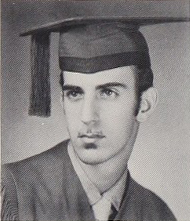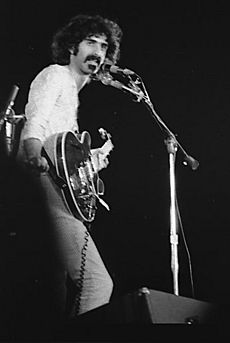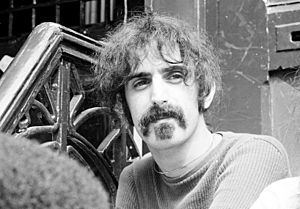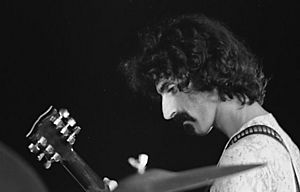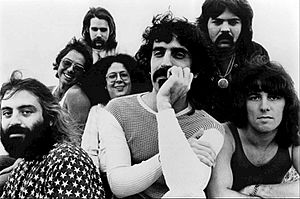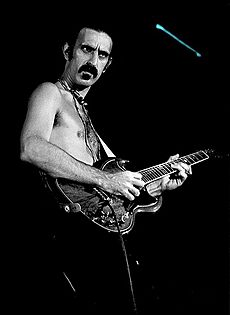Frank Zappa facts for kids
Quick facts for kids
Frank Zappa
|
|
|---|---|
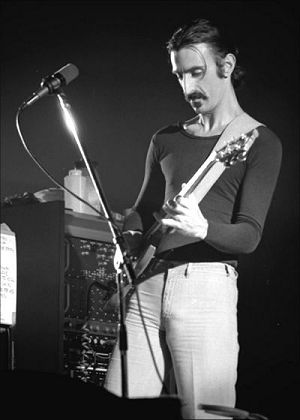
Zappa performing live at Ekeberghallen in Oslo, Norway, 1977
|
|
| Born |
Frank Vincent Zappa
December 21, 1940 |
| Died | December 4, 1993 (aged 52) Los Angeles, California, U.S.
|
| Resting place | Pierce Brothers Westwood Village Memorial Park and Mortuary |
| Occupation |
|
| Years active | 1955–1993 |
| Spouse(s) |
|
| Children |
|
| Musical career | |
| Origin | Los Angeles, California, U.S. |
| Genres |
|
| Instruments |
|
| Labels |
|
Frank Vincent Zappa (December 21, 1940 – December 4, 1993) was an American musician, composer, and bandleader. He was known for his unique style, which often included unusual sounds, musical skill, and funny comments about American culture.
Over 30 years, Zappa created rock, pop, jazz, and classical music. He produced almost all of his more than 60 albums. These were released with his band, the Mothers of Invention, and as a solo artist. Zappa also directed films and music videos. He even designed album covers. Many people see him as one of the most creative and diverse musicians of his time.
Zappa taught himself music. He had many different musical influences, making his music hard to put into one category. As a teenager, he loved 20th-century classical music, African-American rhythm and blues, and doo-wop. He started writing classical music in high school. At the same time, he played drums in R&B bands. Later, he switched to electric guitar.
His first album with the Mothers of Invention, Freak Out! (1966), mixed regular rock and roll songs with group improvisations and studio sound experiments. He kept this varied and experimental style in all his music, whether it was rock, jazz, or classical.
Zappa's work was connected by a concept he called "Project/Object." This meant musical ideas and characters would pop up again in different albums. His song lyrics often showed his strong opinions on society and politics, usually in a funny way. He was called the "godfather" of comedy rock. He strongly believed in freedom of speech, learning on your own, and stopping censorship.
Zappa was a very busy and creative artist. He was more successful outside the U.S., especially in Europe. He worked as an independent artist but often partnered with major record labels for distribution. He still inspires many musicians and composers today. He was honored by being put into the Rock and Roll Hall of Fame in 1995. He also received the Grammy Lifetime Achievement Award in 1997.
Contents
Early Life and Musical Beginnings (1940s–1960s)
Growing Up in the Zappa Family
Frank Zappa was born on December 21, 1940, in Baltimore, Maryland. His mother, Rose Marie, had Italian and French family roots. His father, Francis Vincent Zappa, came from Partinico, Sicily, and had Greek and Arab ancestors.
Frank was the oldest of four children. His Italian-American family often spoke Italian at home. They moved a lot because his father worked in the defense industry as a chemist. After living in Florida for a while, they returned to Maryland. There, Zappa's father worked at a chemical warfare facility. Because their home was close to the facility, they kept gas masks in the house. This experience deeply affected Zappa. He often mentioned germs, defense, and health issues in his music.
Zappa's father sometimes brought mercury-filled lab equipment home. Frank used to play with it. As a child, Zappa was often sick with asthma and sinus problems. A doctor once treated his sinuses by putting a small amount of radium into his nostrils. At that time, people didn't know much about the dangers of radiation. Zappa believed his childhood illnesses might have been from exposure to chemicals nearby. In 1952, his family moved to Monterey, California, for health reasons. They later moved around San Diego before settling in Lancaster.
Discovering Music and Influences
Zappa joined his first band as a drummer at Mission Bay High School in San Diego. Around the same time, his parents bought a record player. This helped him explore music and start his record collection. As a teenager, Zappa loved black R&B, doo-wop, and modern classical composers like Igor Stravinsky and Edgard Varèse.
He bought many R&B singles, building a large collection he kept his whole life. He was fascinated by sounds, especially those from drums and other percussion. By age twelve, he had a snare drum and began learning orchestral percussion. His deep interest in modern classical music began when he read about a record store selling a rare album by Edgard Varèse. The article called Varèse's percussion piece Ionisation "a weird jumble of drums and other unpleasant sounds." Zappa wanted to hear it. After searching for over a year, he found a copy and bought it at a discount. This started his lifelong love for Varèse's music and other modern classical composers. He also enjoyed the Italian classical music his grandparents listened to, especially Puccini's operas.
By 1956, the Zappa family lived in Lancaster, a small town near Edwards Air Force Base. Zappa's mother supported his musical interests. Even though she didn't like Varèse's music, she gave Frank a long-distance call to the composer for his fifteenth birthday. Varèse was in Europe, so Zappa spoke to his wife. Varèse later sent a letter thanking him and mentioning his composition "Déserts." Zappa, living in the desert, found this exciting. He framed the letter and kept it.
At Antelope Valley High School, Zappa met Don Glen Vliet, who later became known as Captain Beefheart. They became close friends, sharing a love for R&B and influencing each other's music. Zappa also started playing drums in a local band called the Blackouts. His interest in guitar grew, and in 1957, he got his first one. He was influenced by guitarists like Johnny "Guitar" Watson and Howlin' Wolf. Zappa saw guitar solos as creating "air sculptures." He developed a unique and personal style.
Zappa's interest in composing grew in high school. In his final year, he wrote and conducted avant-garde pieces for the school orchestra. He graduated in 1958. He later said he was often bored in school and disliked formal education. In 1959, he left home and moved to Echo Park, Los Angeles. He married Kathryn J. "Kay" Sherman in 1960. Zappa briefly worked as a copywriter in advertising. This gave him insights into how the commercial world worked. He always cared about how his work looked, designing album covers and directing films.
Studio Z and Early Recordings
Zappa tried to make a living as a musician. He played gigs in nightclubs. His first professional recordings were soundtracks for low-budget films: The World's Greatest Sinner (1962) and Run Home Slow (1965). The first score had many themes that appeared on Zappa's later records.
In the early 1960s, Zappa wrote and produced songs for other artists. He often worked with singer-songwriter Ray Collins and producer Paul Buff. Buff owned a small studio called Pal Recording Studio. It had a unique five-track tape recorder, which was very advanced for the time. Even though his early recordings weren't big hits, Zappa earned enough to put on a concert of his orchestral music in 1963. He also appeared on Steve Allen's TV show, playing a bicycle as a musical instrument.
In 1964, Zappa moved into the Pal studio. He started working long hours, recording and experimenting with overdubbing and tape manipulation. This became his lifelong work pattern. Zappa took over the studio from Paul Buff and renamed it Studio Z. He also played guitar in a power trio called the Muthers to support himself.
The Mothers of Invention (Late 1960s)
Forming the Band
In 1964, Ray Collins asked Zappa to join his R&B band, the Soul Giants. Zappa became the leader and co-lead singer. He convinced the band to play his original music to get a record deal. The band first played as "the Mothers" on Mother's Day, May 10, 1964. They soon started working with manager Herb Cohen and became known in the Los Angeles underground music scene.
In early 1966, record producer Tom Wilson saw them play. Wilson had produced music for Bob Dylan and Simon & Garfunkel. He signed the Mothers to Verve Records, part of MGM. Verve wanted the band to change their name to the Mothers of Invention.
Freak Out! and New Sounds
With Wilson as producer, the Mothers of Invention recorded Freak Out! (1966). This was a groundbreaking double album, only the second rock double album ever released. It mixed R&B, doo-wop, and experimental sound collages. The album captured the "freak" subculture of Los Angeles. Even though Zappa wasn't fully happy with it, Freak Out! showed him as a new, radical voice in rock music.
The sound was raw, but the music was complex. Some studio musicians were surprised they had to read sheet music and be conducted by Zappa, which was unusual for rock recordings. The lyrics praised being different and made fun of authority. Most songs were written by Zappa, giving him full control over the music. Wilson helped with industry connections and money. However, the recording wasn't perfect. Zappa said the 11-minute closing track, "Return of the Son of Monster Magnet," was unfinished because MGM wouldn't allow more recording time.
During the recording of Freak Out!, Zappa moved into a house in Laurel Canyon. This house became a meeting place for many musicians. After a short tour, Zappa met Adelaide Gail Sloatman. He fell in love quickly, and they married in 1967. They had four children and stayed together until Zappa's death.
The Mothers' second album, Absolutely Free (1967), was also produced by Wilson, but Zappa was mostly in charge. It featured long musical pieces and Zappa's style of sudden rhythm changes. Songs like "Plastic People" criticized American society and the 1960s counterculture. Zappa said, "We're satirists, and we are out to satirize everything." At the same time, Zappa recorded an orchestral album under his own name, Lumpy Gravy. After some legal issues, it was reissued in 1968. It was a very ambitious project, mixing orchestral music, spoken words, and electronic sounds.
New York City Adventures (1966–1968)
The Mothers of Invention played in New York in late 1966. They got a contract to perform at the Garrick Theater, which lasted for half a year. Zappa, his wife Gail, and the band moved to New York. Their shows became a mix of planned music and improvised acts. Zappa directed everything using hand signals. Guest performers and audience participation were common.
In 1967, Zappa created music for a TV commercial for Luden's cough drops. The ad won an award for "Best Use of Sound."
While in New York, the Mothers recorded We're Only in It for the Money (1968). Zappa produced this album. It featured creative audio editing and made fun of the hippie movement. The cover art, designed by Cal Schenkel, parodied the Beatles' Sgt. Pepper's Lonely Hearts Club Band. Schenkel became Zappa's long-time collaborator for album covers.
The next album, Cruising with Ruben & the Jets (1968), was very different. It was a collection of doo-wop songs. People wondered if it was a joke or a tribute.
Zappa also appeared with the Monkees twice. He even had a cameo in their movie Head. Zappa respected the Monkees and tried to recruit Micky Dolenz for the Mothers, but Dolenz couldn't leave his contract.
In the late 1960s, Zappa and Herb Cohen started their own record labels, Bizarre Records and Straight Records. This gave them more creative control and allowed them to release music by other artists.
The Band Breaks Up
The Mothers of Invention returned to Los Angeles in mid-1968. The Zappas moved into a new home, which became Zappa's home for the rest of his life. Even though they were successful in Europe, the Mothers of Invention were not making much money. Their early records had a lot of singing, but Zappa started writing more instrumental jazz and classical music for their concerts. Audiences sometimes found this confusing. Zappa felt people didn't appreciate his "electrical chamber music."
By 1969, there were nine band members, and Zappa was supporting them with his publishing money. In late 1969, Zappa decided to break up the band. He often said it was because of money problems. He also felt the band members weren't always dedicated. Many band members were upset, but some later played with Zappa again. Recordings from this period were released on Weasels Ripped My Flesh and Burnt Weeny Sandwich (both 1970).
After the Mothers broke up, Zappa released his solo album Hot Rats (1969). This album featured Zappa playing long guitar solos for the first time on record. It included "Peaches en Regalia," one of his most famous songs. He was backed by jazz, blues, and R&B musicians. Hot Rats became popular in England and influenced jazz-rock fusion music.
The 1970s: New Bands and Challenges
New Mothers and Filmmaking
In 1970, Zappa met conductor Zubin Mehta. They planned a concert where Mehta conducted the Los Angeles Philharmonic with a rock band. Zappa said he wrote most of the music in motel rooms while on tour. Some of it was later used in the movie 200 Motels. The concert was a success, but Zappa was not happy working with a symphony orchestra. This feeling continued throughout his career; he often felt that orchestras didn't play his music as well as he wanted, considering the money he spent.
Later in 1970, Zappa formed a new version of the Mothers. This group included drummer Aynsley Dunbar, keyboardist George Duke, Ian Underwood, and singers Mark Volman and Howard Kaylan (known as "Flo & Eddie").
This new Mothers band first appeared on Zappa's album Chunga's Revenge (1970). This was followed by the double-album soundtrack for the movie 200 Motels (1971). The film featured the Mothers, the Royal Philharmonic Orchestra, and even Ringo Starr. Zappa co-directed the film, which was shot in a week near London. The movie was about life on the road as a rock musician. It was one of the first feature films filmed on videotape and then transferred to film, allowing for new visual effects. The film received mixed reviews. Zappa's frustration with the classical music world grew when a concert planned after filming was canceled.
After 200 Motels, the band toured. This led to two live albums, Fillmore East – June 1971 and Just Another Band from L.A.. The latter included the 20-minute song "Billy the Mountain," Zappa's funny take on rock opera. This song showed how theatrical the band's performances were.
Accidents and Recovery
On December 4, 1971, Zappa faced a serious challenge. While performing in Switzerland, an audience member set off a flare, causing a fire that destroyed the casino and the Mothers' equipment. This event is famously mentioned in Deep Purple's song "Smoke on the Water."
After losing $50,000 worth of equipment, the Mothers played a show in London with rented gear. During the encore, an audience member pushed Zappa off the stage into a concrete orchestra pit. The band thought he was killed.
After this attack, Zappa had to use a wheelchair for a long time. He couldn't tour for over half a year. When he returned to the stage in September 1972, he still wore a leg brace and had a limp. He noted that one leg healed "shorter than the other," which caused him chronic back pain.
Jazz-Oriented Albums and a Top 10 Hit
While recovering in 1971–1972, Zappa released two jazz-focused solo albums: Waka/Jawaka and The Grand Wazoo. These albums featured long instrumental tracks with extended solos, similar to Hot Rats. Zappa started touring again in late 1972. He first performed with a 20-piece big band called the Grand Wazoo. Then, he toured the U.S. with a smaller group called the Petit Wazoo.
Zappa then formed smaller touring groups. These often included Ian Underwood (reeds, keyboards), Ruth Underwood (vibes, marimba), Napoleon Murphy Brock (sax, flute, vocals), and George Duke (keyboards, vocals).
By 1973, Zappa and Cohen started a new record label, DiscReet Records. Zappa continued to release many albums. His solo album Apostrophe (') (1974) reached No. 10 on the Billboard pop album charts. This was helped by the song "Don't Eat The Yellow Snow," which reached No. 86. Other albums from this time include Over-Nite Sensation (1973), with concert favorites like "Dinah-Moe Humm" and "Montana." The albums Roxy & Elsewhere (1974) and One Size Fits All (1975) featured different versions of the Mothers band. These albums are known for their tight performances of difficult jazz fusion songs.
Business Changes and Touring
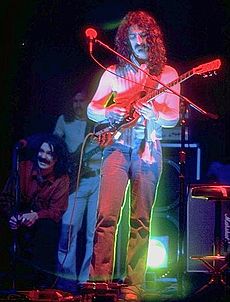
In 1976, Zappa's relationship with his long-time manager Herb Cohen ended. Zappa sued Cohen over money issues. This legal battle also stopped Zappa from accessing his earlier recordings. Because of this, Zappa's only income came from touring. He toured a lot from 1975 to 1977 with smaller, rock-focused bands. Drummer Terry Bozzio became a regular member.
In December 1976, Zappa appeared on the TV show Saturday Night Live. He performed his song "I'm the Slime." In 1978, Zappa hosted Saturday Night Live and performed music. He even played with cast member John Belushi.
Zappa's band played a series of Christmas shows in New York City in 1976. Recordings from these shows appear on Zappa in New York (1978). The band included Ruth Underwood and a horn section. The album mixed complex instrumental songs like "The Black Page" with humorous songs. "The Black Page" is known for its complex rhythms.
Zappa Records and Joe's Garage
In 1979, Zappa released two important projects. One was Sheik Yerbouti, his best-selling album. It included the Grammy-nominated song "Dancin' Fool." It also had "Jewish Princess," which caused some controversy. Zappa denied any bad intentions. The album's success was also due to "Bobby Brown." This song had explicit lyrics and wasn't played on U.S. radio, but it was a hit in several European countries.
The other major project was Joe's Garage. This was a rock opera about the dangers of political systems and the suppression of freedom of speech and music. It was inspired partly by the 1979 Iranian revolution, which made music illegal.
Around August 1979, Zappa cut his long hair. That fall, he canceled tour plans to spend time with his children for their birthdays. At this time, Zappa also finished building his own recording studios, the Utility Muffin Research Kitchen (UMRK), at his house. This gave him complete freedom in his work.
On December 21, 1979, Zappa's movie Baby Snakes premiered in New York. The movie was based on concert footage from Halloween 1977. It also included amazing clay animation by Bruce Bickford. The movie didn't do well in theaters but won an award at a music festival in Paris in 1981.
The 1980s and Beyond
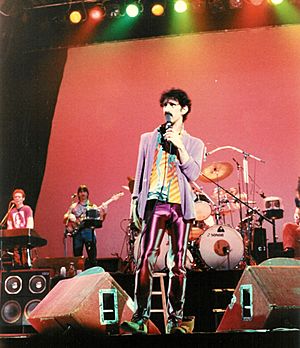
Zappa ended his relationship with Phonogram after they refused to release his song "I Don't Wanna Get Drafted" in 1980. He released the single independently in the U.S.
After touring a lot in 1980, Zappa released Tinsel Town Rebellion in 1981. This was the first album on his own Barking Pumpkin Records label. It featured songs from his 1979 and 1980 tours. The album mixed complex instrumental pieces with Zappa's unique "speaking song" style. It showcased some of the best bands Zappa ever had. Guitarist Steve Vai joined Zappa's touring band in late 1980.
The same year, the double album You Are What You Is was released. It included a complex instrumental song but mostly consisted of rock songs with Zappa's sarcastic social comments. He made fun of teenagers, the media, and religious and political hypocrisy. Songs like "Dumb All Over" criticized religion and TV evangelists. Zappa made his only music video for the song "You Are What You Is." MTV banned the video, but it was later shown on Beavis & Butthead.
In 1981, Zappa also released three instrumental albums focused on his guitar playing: Shut Up 'n Play Yer Guitar, Shut Up 'N Play Yer Guitar Some More, and The Return of the Son of Shut Up 'N Play Yer Guitar. These albums highlighted Zappa's amazing improvisational skills. Two more guitar-focused albums, Guitar (1988) and Trance-Fusion (2006, released after his death), followed.
Zappa also appeared on TV in non-musical roles. He was an actor or voice artist in shows like Shelley Duvall's Faerie Tale Theatre and Miami Vice.
"Valley Girl" and Classical Music
In May 1982, Zappa released Ship Arriving Too Late to Save a Drowning Witch. This album featured his biggest hit single, the Grammy-nominated song "Valley Girl." It reached No. 32 on the Billboard charts. Zappa's daughter Moon improvised the lyrics, making fun of the way teenage girls from the San Fernando Valley spoke. This song popularized many "Valspeak" phrases like "gag me with a spoon" and "fer sure, fer sure."
In 1983, Zappa released two different projects. The Man from Utopia was a rock album. The second album, London Symphony Orchestra, Vol. I, contained Zappa's orchestral music performed by the London Symphony Orchestra (LSO). A second record from these sessions, London Symphony Orchestra, Vol. II, was released in 1987. Zappa funded these recordings himself, helped by the success of "Valley Girl." However, Zappa was not happy with the LSO recordings, feeling they were not rehearsed enough.
Conductor Kent Nagano, who worked with Zappa, said that "in fairness to the orchestra, the music is humanly very, very difficult." Some critics said these recordings were the best examples of Zappa's orchestral work so far. In 1984, Zappa's management relationship ended. From then on, his wife Gail managed all his business interests with him.
Synclavier Music
For the rest of his career, Zappa used the Synclavier, an early digital synthesizer, a lot. He said, "With the Synclavier, any group of imaginary instruments can be invited to play the most difficult passages... with one-millisecond accuracy—every time." Zappa saw the Synclavier and real musicians as separate tools.
In 1984, he released four albums. Boulez Conducts Zappa: The Perfect Stranger included orchestral works conducted by the famous conductor Pierre Boulez. These were mixed with new Synclavier pieces. Zappa was still not happy with the orchestral performances, but he thanked Boulez for his precision.
The album Thing-Fish was a three-record set like a Broadway play. It explored a future world with themes of feminism, homosexuality, and government programs. It combined new vocals with older tracks and new Synclavier music.
Francesco Zappa, a Synclavier version of works by an 18th-century composer, was also released in 1984.
Digital Music and Last Tour
Around 1986, Zappa started re-releasing his older vinyl records as digital compact discs. He personally oversaw the process. Some fans criticized these re-issues for not being exactly like the originals. Years before online music stores, Zappa suggested replacing physical records with "direct digital-to-digital transfer" through phone or cable TV.
The album Jazz from Hell (1986) earned Zappa his first Grammy Award in 1988 for Best Rock Instrumental Performance. Except for one live guitar solo, this album was made entirely with the Synclavier.
Zappa's last tour with a rock and jazz band was in 1988. The 12-member group had over 100 songs in their repertoire. The tour ended early due to disagreements within the band. This tour was documented on albums like Broadway the Hard Way (new songs with strong political messages), The Best Band You Never Heard in Your Life (Zappa's classic songs and cover tunes), and Make a Jazz Noise Here.
Health Challenges and Final Works
In 1990, Zappa was diagnosed with a serious illness. It had been developing for years and could not be treated with surgery. After the diagnosis, Zappa focused most of his energy on modern orchestral and Synclavier works. Shortly before his death in 1993, he finished Civilization Phaze III, a major Synclavier work he had started in the 1980s.
In 1991, Zappa was chosen as one of four featured composers for the Frankfurt Festival in 1992. The German chamber group Ensemble Modern wanted to play his music. Even though he was ill, he invited them to Los Angeles to rehearse new compositions. Zappa got along well with the musicians. Concerts in Germany and Austria were planned for later that year. Zappa also performed in Prague in 1991.
In September 1992, the concerts happened, but Zappa could only appear at two in Frankfurt due to his illness. At the first concert, he conducted the opening piece. He received a 20-minute standing ovation. This was Zappa's last public appearance because his illness caused him too much pain to enjoy the event fully. Recordings from these concerts appeared on The Yellow Shark (1993), Zappa's last release during his lifetime.
Death
Frank Zappa died from his illness on December 4, 1993, 17 days before his 53rd birthday. He was at his home with his wife and children. His body was buried in an unmarked grave at the Westwood Village Memorial Park Cemetery in Los Angeles. On December 6, his family announced that "Composer Frank Zappa left for his final tour just before 6:00 pm on Saturday."
Musical Style and Development
Music Genres
Zappa's music has been described as many different styles. These include experimental rock, jazz, classical, comedy rock, doo-wop, jazz fusion, and progressive rock.
Influences and "Project/Object"
Zappa was influenced by avant-garde composers like Edgard Varèse and Igor Stravinsky. He also loved 1950s blues artists like Johnny "Guitar" Watson and Howlin' Wolf, and R&B and doo-wop groups. His own diverse background and the mix of cultures in Los Angeles shaped his music. He often made fun of musical trends like psychedelia and disco. Television also influenced him, with references to show themes and jingles in his later works.
In his book The Real Frank Zappa Book, Zappa said composer Spike Jones influenced his use of funny sound effects and humorous percussion. He said, "I owe this part of my musical existence to Spike Jones."
Zappa's albums often had songs that flowed into each other without breaks. All his work was connected by a concept he called "Project/Object," or "conceptual continuity." This meant that musical ideas and characters would reappear in different forms on later albums.
Guitar Playing and Tape Experiments
Guitar Playing
Zappa is known as one of the most important electric guitar soloists. In 1983, Guitar World magazine called him "one of the greatest guitarists we have." His unique style grew over time. By the early 1980s, his live shows featured long, improvised solos. Guitar Player magazine described his solos as "more akin to symphonies than they are to guitar solos." This is because he often repeated melodic themes with variations, like in a symphony. He used many different scales and rhythms. His left hand was smooth, and his right hand was very fast at picking.
Zappa's song "Outside Now" from Joe's Garage made fun of people who didn't like his guitar style. The song's character imagines "imaginary guitar notes that would irritate/An executive kind of guy." This is followed by one of Zappa's unique solos.
Some critics did not like Zappa's guitar style. English guitarist John McLaughlin said Zappa was a "very good musician" but that his long guitar solos (10–15 minutes) were "a little bit boring."
In 2000, VH1 ranked him number 36 on its list of "100 Greatest Artists of Hard Rock." In 2004, Rolling Stone magazine ranked him number 71 on its list of the "100 Greatest Artists of All Time." In 2011, he was ranked number 22 on their list of the "100 Greatest Guitarists of All Time."
Tape Manipulation
In New York, Zappa started using tape editing as a way to compose music. A good example is on the album Uncle Meat (1969), where the song "King Kong" is edited from different studio and live performances. Zappa regularly recorded concerts. Because he insisted on precise tuning and timing, he could mix parts from live shows into his studio recordings, and vice versa. Later, he combined recordings of different songs into new pieces, even if they had different tempos. He called this "xenochrony" (strange synchronizations).
Personal Life
Zappa was married to Kathryn J. "Kay" Sherman from 1960 to 1963. In 1967, he married Adelaide Gail Sloatman. He and Gail had four children: Moon, Dweezil, Ahmet, and Diva.
After Zappa's death, his wife Gail created the Zappa Family Trust. This trust owns the rights to Zappa's music and other creative works. Zappa released over 60 albums during his life, and 40 more were released after his death. When Gail died in 2015, the Zappa children received shares of the trust.
Beliefs and Politics
Views on Government and Religion
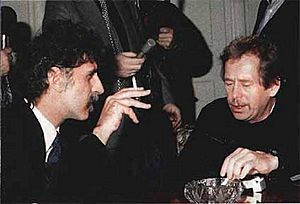
In a 1991 interview, Zappa said he was a registered Democrat but that he might change that. He described his political views as "practical conservative." He supported limited government and low taxes. He also approved of national defense and social security, but only if people could pay for them. He was against military drafts, believing military service should be voluntary. He supported capitalism and independent businesses. He was against communism, saying, "A system that doesn't allow ownership... has—to put it mildly—a fatal design flaw."
He always encouraged his fans to register to vote on his album covers. In 1988, he even had voter registration booths at his concerts. He considered running for president as an independent.
Zappa was an atheist. He felt strongly against organized religion, especially Christianity. He believed it promoted ignorance and was against gaining knowledge. Some of his songs and public discussions in the 1980s criticized Republicans and their policies, like President Ronald Reagan and TV evangelists. He warned that the U.S. government was in danger of becoming a "fascist theocracy."
In early 1990, Zappa visited Czechoslovakia at the request of President Václav Havel. Havel admired Zappa's commitment to individual freedom. Havel named Zappa Czechoslovakia's "Special Ambassador to the West on Trade, Culture and Tourism." Havel was a lifelong fan of Zappa, who influenced the underground music scene in Central Europe. A Czech rock group that was imprisoned in 1976 took its name from Zappa's song "Plastic People." Due to pressure from the U.S. Secretary of State, Zappa's official role was changed to an unofficial cultural advisor. Zappa planned to help businesses trade between the former Eastern Bloc and Western countries.
Fighting Censorship
Zappa spoke out against censorship. On September 19, 1985, he testified before the United States Senate Commerce, Technology, and Transportation committee. He spoke against the Parents Music Resource Center (PMRC), a group co-founded by Tipper Gore, wife of then-senator Al Gore. The PMRC wanted to address song lyrics with "satanic content." Zappa argued that the PMRC had a conflict of interest because its founders were related to politicians who were trying to pass a "Blank Tape Tax."
Zappa saw the PMRC's actions as a step towards censorship. He called their idea for voluntary labeling of records with explicit content "extortion" of the music industry.
Legacy and Influence
Zappa's critical standing was debated during his life. Some, like conductor Kent Nagano and President Václav Havel, called him a genius. However, he was rejected twice for the Rock and Roll Hall of Fame during his lifetime. Some critics felt his music lacked emotional depth.
Praise and Honors
The Rolling Stone Album Guide (2004) said: "Frank Zappa dabbled in virtually all kinds of music—and, whether guised as a satirical rocker, jazz-rock fusionist, guitar virtuoso, electronics wizard, or orchestral innovator, his eccentric genius was undeniable." Even though his work drew from many genres, Zappa created a clear and personal style.
In 1980, biographer David Walley noted that "The whole structure of his music is unified, not neatly divided by dates or time sequences and it is all building into a composite."
Barry Miles noted in 2004 that Zappa's music, politics, and philosophy were all connected: "It was all one; all part of his 'conceptual continuity.'"
Guitar Player magazine dedicated a special issue to Zappa in 1992. They asked on the cover, "Is FZ America's Best Kept Musical Secret?" The editor called him "The most important composer to come out of modern popular music."
Composer and music expert Nicolas Slonimsky, who became friends with Zappa, said, "I admire everything Frank does, because he practically created the new musical millennium. He does beautiful, beautiful work... It has been my luck to have lived to see the emergence of this totally new type of music."
Conductor Kent Nagano said, "Frank is a genius. That's a word I don't use often... In Frank's case it is not too strong... He is extremely literate musically. I'm not sure if the general public knows that." Pierre Boulez said Zappa "was an exceptional figure because he was part of the worlds of rock and classical music and that both types of his work would survive."
In 1994, jazz magazine DownBeat put Zappa in its Hall of Fame. Zappa was inducted into the Rock and Roll Hall of Fame in 1995. There, it was written that "Frank Zappa was rock and roll's sharpest musical mind and most astute social critic. He was the most prolific composer of his age, and he bridged genres—rock, jazz, classical, avant-garde and even novelty music—with masterful ease."
In 2005, the U.S. National Recording Preservation Board added We're Only in It for the Money to the National Recording Registry. They said it was "Frank Zappa's inventive and iconoclastic album presents a unique political stance, both anti-conservative and anti-counterculture, and features a scathing satire on hippiedom and America's reactions to it." The same year, Rolling Stone magazine ranked him at No. 71 on its list of the 100 Greatest Artists of All Time. In 2011, he was ranked at No. 22 on the list of the 100 Greatest Guitarists of All Time by the same magazine.
The street in Partinico, Sicily, where his father lived, has been renamed Via Frank Zappa.
Grammy Awards
Zappa was nominated for nine Grammy Awards and won two (one after his death). In 1998, he received the Grammy Lifetime Achievement Award.
| Year | Nominee / work | Award | Result |
|---|---|---|---|
| 1980 | "Rat Tomago" | Best Rock Instrumental Performance | Nominated |
| "Dancin' Fool" | Best Male Rock Vocal Performance | Nominated | |
| 1983 | "Valley Girl" | Best Rock Performance by a Duo or Group with Vocal | Nominated |
| 1985 | The Perfect Stranger | Best New Classical Composition | Nominated |
| 1988 | "Jazz from Hell" | Best Instrumental Composition | Nominated |
| Jazz from Hell | Best Rock Instrumental Performance (Orchestra, Group or Soloist) | Won | |
| 1989 | Guitar | Nominated | |
| 1990 | Broadway the Hard Way | Best Musical Cast Show Album | Nominated |
| 1996 | Civilization Phaze III | Best Recording Package – Boxed | Won |
| 1998 | Frank Zappa | Lifetime Achievement Award | Honored |
Artists Influenced by Zappa
Many musicians, bands, and orchestras from different genres have been influenced by Zappa's music. Rock artists like The Plastic People of the Universe, Alice Cooper, and Larry LaLonde of Primus mention Zappa's influence. So do progressive, alternative, electronic, and avant-garde artists like Can, Pere Ubu, Yes, Soft Machine, Kraftwerk, Trey Anastasio of Phish, and John Frusciante. Paul McCartney thought the Beatles' Sgt. Pepper's Lonely Hearts Club Band was their Freak Out!. Jimi Hendrix and heavy rock/metal bands like Black Sabbath and System of a Down have also said Zappa inspired them.
In classical music, groups like Tomas Ulrich and Meridian Arts Ensemble regularly perform Zappa's compositions. Jazz musicians like Bobby Sanabria and John Zorn are inspired by him, as is funk legend George Clinton.
Other artists influenced by Zappa include ambient composer Brian Eno, new age pianist George Winston, and parodist "Weird Al" Yankovic.
Zappa Documentary
The biographical documentary Zappa, directed by Alex Winter, was released on November 27, 2020. It includes footage from Zappa's personal collection that had never been seen before.
Discography
During his lifetime, Zappa released 62 albums. Since 1994, the Zappa Family Trust has released 57 albums after his death, making a total of 119 albums. In June 2022, the Zappa Trust sold Zappa's entire music catalog to Universal Music.
|
See also
 In Spanish: Frank Zappa para niños
In Spanish: Frank Zappa para niños
- List of performers on Frank Zappa records
- Frank Zappa in popular culture


